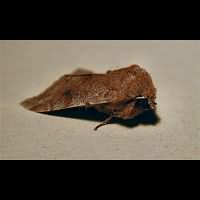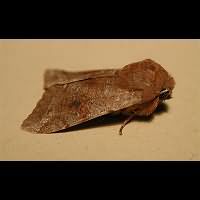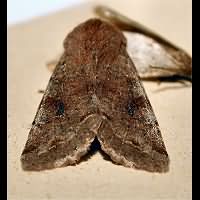Clouded Drab Orthosia incerta
The Clouded Drab does lack striking colours indeed. But it also is a highly variable species. Yet usually easily identified. First of all because it is one of the biggest among the Drabs and Quakers. It is also one of the earliest to appear. Furthermore it has a typical shape: the tip of the wings is very angular, where it is more rounded in the other species. The wavy line (which is the line just before the side edge of the wing) is white or yellowish, wavy and has some black spots near the indents. The wing gives the impression of being stained but doesn't show any concrete or well defined markings. The colour is highly variable: from almost black and practically unmarked through brown to ochreous or light grey. The lighter the animal the more distinct the markings are. Some specimens however are light brown with lots of dark brown speckles and have no other markings whatsoever. Between all these appearances there is a lot of overlap. The Powdered Quaker often is very similar, but its wavy line is almost completely straight and it has a warmer colour. The Northern Drab not only is smaller, it also has pointed wing tips and a very hairy thorax. The Clouded Drab has a wing span of 34 to 42mm.
The eggs are laid in springtime in small groups on the host plant. They hatch after some 10 days. The newly hatched caterpillars live inside buds. When they grow too big, they spin two or more leaves together and hide between the leaves during the day. At night they feed by eating other leaves. When almost full grown the caterpillars hide between plant debris or in the foodplant close to the ground. In June or July the caterpillars are fully grown. They now go underground, spin a very thin cocoon and pupate. The pupa overwinters, more or less. The caterpillar of the Clouded Drab is green with lots of whitish or yellowish speckles. Just above the spiracula runs a rather broad white line from head to tail. It is accompanied by a very thin black line above. The caterpillar has a green head and reaches a length of some 40mm. It is often found in trees, such as willow, oak and apple. But it also feeds on low growing plants like docks and hop.
The Clouded Drab is among the first moths to be on the wing in spring. Sometimes the animals fly about in January. Most however start flying in February as soon as the weather gets milder. And even though they may still be on the wing in June, numbers sharply decline by mid-May. The Clouded Drab only flies during the hours of darkness, but it may be seen visiting flowers in lights. It is very fond of catkins. The moth is easily attracted to both light and sugar. During daylight it can be photographed with ease. Will often not move at all, which means however it is quite difficult to manipulate, should you wish to do so. It is indifferent towards the habitat: light forests, roughs, parks and gardens will do. A common species all over the British Isles. Common in Western, Central and Northern Europe too.
The Clouded Drab does lack striking colours indeed. But it also is a highly variable species. Yet usually easily identified. First of all because it is one of the biggest among the Drabs and Quakers. It is also one of the earliest to appear. Furthermore it has a typical shape: the tip of the wings is very angular, where it is more rounded in the other species. The wavy line (which is the line just before the side edge of the wing) is white or yellowish, wavy and has some black spots near the indents. The wing gives the impression of being stained but doesn't show any concrete or well defined markings. The colour is highly variable: from almost black and practically unmarked through brown to ochreous or light grey. The lighter the animal the more distinct the markings are. Some specimens however are light brown with lots of dark brown speckles and have no other markings whatsoever. Between all these appearances there is a lot of overlap. The Powdered Quaker often is very similar, but its wavy line is almost completely straight and it has a warmer colour. The Northern Drab not only is smaller, it also has pointed wing tips and a very hairy thorax. The Clouded Drab has a wing span of 34 to 42mm.
The eggs are laid in springtime in small groups on the host plant. They hatch after some 10 days. The newly hatched caterpillars live inside buds. When they grow too big, they spin two or more leaves together and hide between the leaves during the day. At night they feed by eating other leaves. When almost full grown the caterpillars hide between plant debris or in the foodplant close to the ground. In June or July the caterpillars are fully grown. They now go underground, spin a very thin cocoon and pupate. The pupa overwinters, more or less. The caterpillar of the Clouded Drab is green with lots of whitish or yellowish speckles. Just above the spiracula runs a rather broad white line from head to tail. It is accompanied by a very thin black line above. The caterpillar has a green head and reaches a length of some 40mm. It is often found in trees, such as willow, oak and apple. But it also feeds on low growing plants like docks and hop.
The Clouded Drab is among the first moths to be on the wing in spring. Sometimes the animals fly about in January. Most however start flying in February as soon as the weather gets milder. And even though they may still be on the wing in June, numbers sharply decline by mid-May. The Clouded Drab only flies during the hours of darkness, but it may be seen visiting flowers in lights. It is very fond of catkins. The moth is easily attracted to both light and sugar. During daylight it can be photographed with ease. Will often not move at all, which means however it is quite difficult to manipulate, should you wish to do so. It is indifferent towards the habitat: light forests, roughs, parks and gardens will do. A common species all over the British Isles. Common in Western, Central and Northern Europe too.







